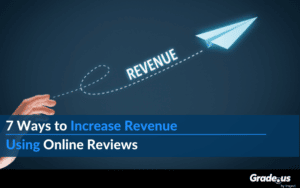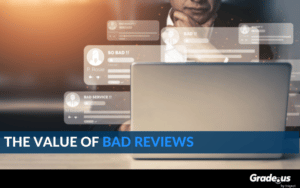Your customers won't read.
Jakob Nielsen, usability expert with the Nielsen Norman Group, states repeatedly that people don't read. When it comes to online content customers don't read, they scan.
How bad is it?
Nielsen goes on to state, "On the average Web page, users have time to read at most 28% of the words during an average visit; 20% is more likely."
It's not just Nielsen.
Research shows readers scan. Large online publications like the New York Times and Slate agree. You're not going to read this article from beginning to end.
No one is interested in anything you have to say
That's the fear, right?
You're afraid that customers won't be interested in anything your business has to say. The worst part of this is the fact that you know, for the most part, it's true.
People aren't interested.
Here's the catch and your opportunity. Customers care about you when they know you genuinely care more about them. Once they believe in you, your platform or what you have to say - things begin to look very different.
They begin to read.
How do we know? They tell us. Medium.com analyzed 10,000+ data points to figure out whether people read or not. They found people are eager to read good content if it:
- Is written at a 6th grade reading level
- Uses 12 – 15 words per sentence and is easy to read
- Can be read within 6 to 7 minutes
- Uses power words like best, definitive, great, etc.
- Relies on sentence case rather than title case
Not only do people read, research shows they're interested in long form content. Here's the catch. Your content has to be concise, scannable and objective. It also has to be content they're interested in reading.
Okay, what do customers want to read?
Customers are less interested in what you have to say...
And more interested in what other customers have to say about you, at least at first. The Pew Research Center found 67 percent of weekly shoppers and 50 percent of shoppers overall read online reviews.
Which is where review snippets come in.
Google testing mini-reviews in local pack (cc @mblumenthal) -- pic.twitter.com/RBWJYlB9F4
— Dr. Pete Meyers (@dr_pete) April 4, 2016
Customers use Google to search for what they want. What's the very next thing they do?
They scan!
Potential customers quickly scan the search results in front of them, looking for anything that grabs their attention or turns them off. If they see positive reviews they dig deeper, lots of negative reviews and they move on.
They haven't clicked through yet.
They're scanning for information, which means you're vulnerable. Let's say you outrank a competitor in Google. You have spots 1 to 3 in the search results for your desired keywords. But they have a few review snippets showing off their 5 star reviews. Who's going to get the click?
You or them?
Research shows we use as much as 60 percent of our brain for visual processing. There's also the fact that shoppers are conditioned to respond to 5 stars. They know exactly what fifteen hundred 5-star reviews mean.
Safety.
That's bad news for those without review snippets. Maybe they'll come back and maybe they'll run into you in the future, but it's less likely without the right introductions.
Review snippets draw scanners in
What exactly are review snippets? Google breaks it down for us.
"A rich result (previously known as a rich snippet) of a review or rating markup from a review website, usually an average of the combined rating scores from reviewers. Review snippets appear in Google Search results either under the search result or in the Google Knowledge Cards."
So, Google combines scores from review websites and displays your average rating? Nice!
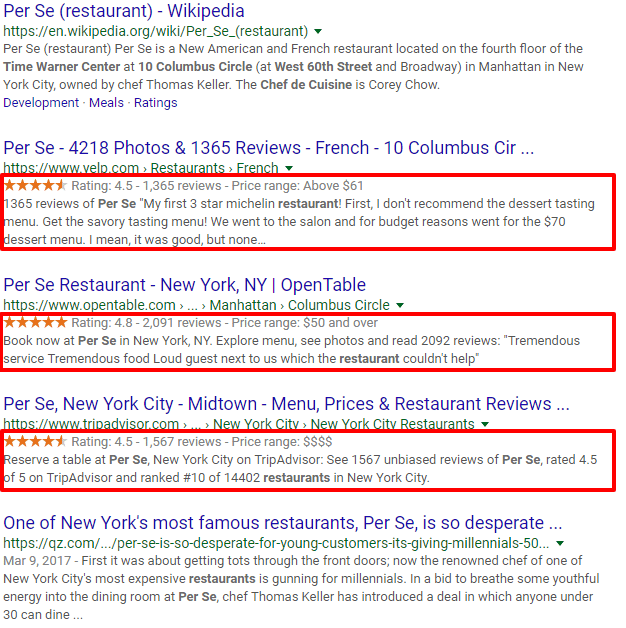
Google provides review snippets for local businesses, movies, books, music and products in general. That's important because it tells you where their focus is and how it applies to your business.
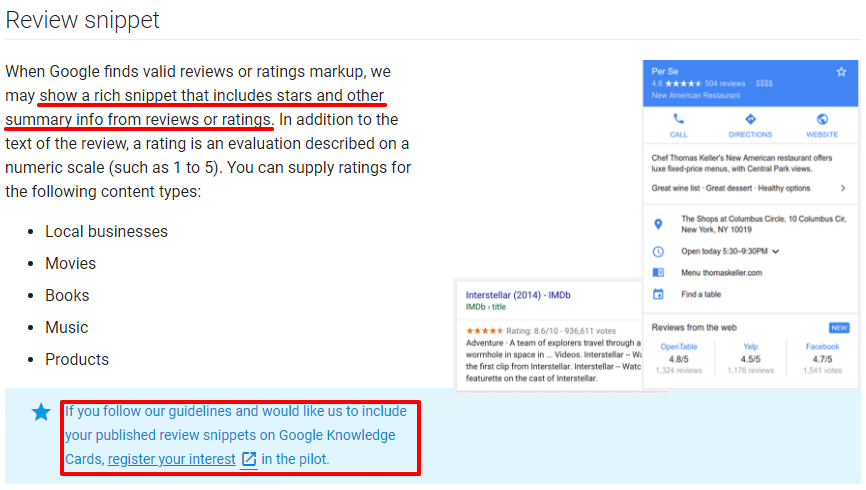
These "review snippets" come in two varieties.
1. The Critic Review. It's a single review article that has been written, published or curated for your business. It's a notable review from a local food critic, product or app reviews from tech publications (e.g. Ars Technica, CNET, TechCrunch, etc.).
2. Review Snippets. A review snippet that's pulled from a review website and included in search results or knowledge graph cards.
Which one do you need?
It really depends on your goal. If you're looking to maximize online visibility for your business you'll need both. That makes sense when you think about it. Focusing on both snippet types maximizes your visibility which, when combined with search rankings, enables you to dominate results pages.
Like this.
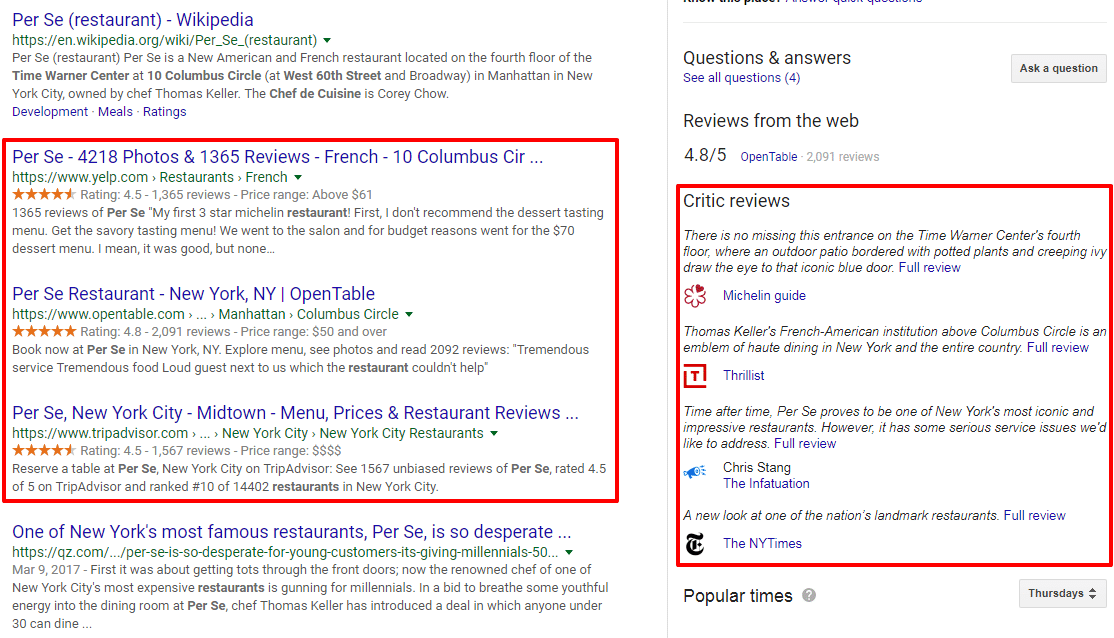
Is it really that important though?
It seems like such a small detail. It can't make that much of a difference, can it? It can, and it does make a big difference. In a recent post, SEMRush found several domains received a significant amount of organic traffic from, you guessed it, review snippets.
· MedicalNewsToday.com receives 48.71 percent of its organic keywords from review snippets
· A whopping 70 percent of organic keywords for AllRecipes.com are being generated from review snippets
· 66 percent of organic keywords for FoodNetwork.com come from review snippets
Looking at several top 500 domains, we see that review snippets play a much bigger role than expected.
Can you actually use keywords and review snippets to maximize your online visibility and outperform your competitors? Or, is this more theoretical?
Is this a practical goal to have?
Absolutely.
With the right approach you can use review snippets to attract a significant amount of attention and shutdown your competitor. But it starts with clarity about your situation and a plan.
Is your review portfolio where it should be?
It's okay if it's not.
It may be bad news, but it's good news to know. It's important to have an honest discussion with your team (or yourself) about where you are right now. You have a poor review portfolio if you...
1. Have no reviews
2. Don't have enough positive reviews
3. Have an imbalanced portfolio (all your reviews are on Facebook, none on Google or Yelp)
4. Have very few reviews overall
5. Receive reviews from the wrong customer (or customer predators)
6. Have lots of short, poorly written reviews
If any of these are a problem for you, they need to be addressed before any work with review snippets begins. A well-rounded review portfolio is an important prerequisite that demonstrates you're running a quality business.
Already taken care of that?
Good. Let's dive in.
Step #1: Identify review snippet keywords
You can use a tool like SEMRush to identify review snippet keywords. These keywords trigger/display review snippets whether they're visible in search results or displayed in the knowledge cards.
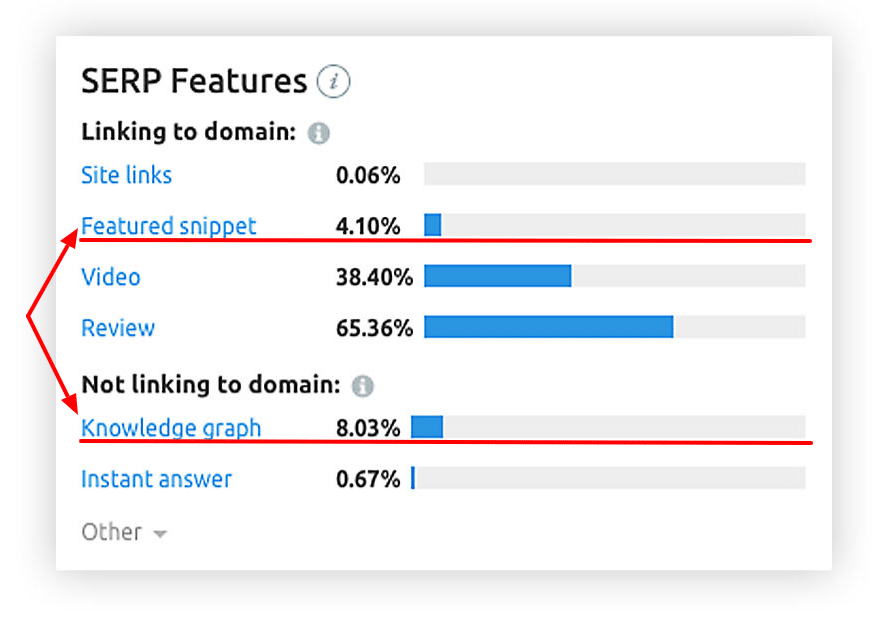
Next, you'll want to sort through your list of keywords, segmenting them as necessary. For example, you could segment your list based on the customer buying cycle. You could sort keywords into buckets, based on where your customers are in the purchase process.
· Awareness. Your customers are aware they have a problem. This realization prompts them to search for a solution to their problem. Customers at this stage often use broad, generic or vague head keywords (e.g. email marketing, business reviews, etc.)
· Research. Customers are looking for a specific way to solve their problem. They're learning about the market and identifying the various options they can take. (e.g. how to, what is, why does, what ifs, etc.)
· Comparison. In this stage, customers use reviews, case studies, pricing, etc. to comparison shop. They're looking for the best solution to their problem so their keywords tend to be more decision oriented (e.g. Nikon vs. Canon cameras, Yext alternatives, etc.)
· Retention. Customers are either happy or unhappy, satisfied or unsatisfied. Requesting a review is important at this stage because it gets customers to own their experience. If they're happy that's good news. If they're unhappy you're far more likely to get an earful or a negative review. You may also notice your customers searching for something different (e.g. Yext alternatives, Walmart sucks, or Neiman Marcus sucks).
Once you've placed your keywords into the appropriate buckets you're ready to...
Step #2: Curate customer reviews
At this point, you're essentially playing the role of matchmaker. Sort your customer reviews into buckets as well. Divide customer reviews into groups (a.) helpful reviews from raving fans (b.) objective reviews from neutrals (c.) short, concise reviews and (d.) negative reviews from unsatisfied/unhappy customers.
Your goal at this stage is simple.
Match customer reviews to the appropriate keywords in your bucket. At first glance this seems pointless. It's not like you can control what your customer says in their reviews now is it? And even if you could, wouldn't that be dishonest?
No actually.
There is a way for you to get customers to say what you want them to say without coercion, dishonesty or manipulation?
How?!
You ask the right questions.
Ask the right five or six questions and customers will give you the important details you need. Ask these questions and you'll find customers will...
- Defuse customer objections for you
- Share their fears and frustrations
- Discuss their problems in detail
Share your product or service with critics, then ask them the same five or six questions. Ask these critics if they'd be willing to discuss their recommendations with you before publishing their feedback.
This needs to be systematic and consistent.
Consistently ask your customers for their feedback (good or bad). Reach out to critics and professional reviewers for their honest feedback.
Step #3: Syndicate your review content
You'll want to share your reviews with prospective customers.
· Add reviews to AdWords ads. You've already matched your keywords and reviews. Now just share excerpts of your positive reviews with customers in your ad copy. Use the same exact review and customer photo in your landing pages to maintain ad scent.
· Share video testimonials or case studies. Reach out to customers who have agreed to share a positive review. It's ideal if the customers you reach out to are admirers or raving fans. Ask if they'd be willing to discuss their review on video. Then, with their permission, share their review on YouTube. Optimize your title, descriptions and meta information for search. Provide YouTube with a transcript of your video to improve performance.
· Retarget prospective customers in your sales funnel. Use Facebook, Instagram and display advertising to target interested prospects who haven't converted. Pair your reviews with an irresistible, time sensitive offer that motivates customers to make a decision in your favor.
· Add positive reviews to email confirmation pages. Show subscribers that you're the best choice. Give them a compelling reason to buy your products, sign-up for your product or service or simply build awareness. Sprinkle reviews into autoresponder sequences, launch emails, affiliate offers, etc.
The possibilities are endless, aren't they?
Each of these syndication strategies amplifies the strength of your review snippets. Your review snippets attract the lion's share of attention upfront, but your syndication strategies reinforce your position of trust and close the sale.
It's a straightforward way to dominate your competitors.
Using influential sites with significant amounts of domain trust, you can keep your customer's attention focused on you. A multi-channel approach is the key to success.
You can't control what goes into review snippets...
But you can influence what goes into your reviews. The very same reviews Google uses to build their snippets. Here's the thing though, it's not about control. It's about consistency.
Ask customers and critics for what you want.
Do it consistently, do it often. Focus on building a quality business that goes above and beyond to serve your customers. Then, get customers to share their feedback with you.
Complete your GMB profile. Make sure your profile is complete, up-to-date and full of photos. Verify your locations, make sure your data is accurate. Build a prominent brand that's focused on your customers.
Your customers aren't interested in reading.
Experience has taught them to scan for the information they need. Customers read, but only after they've identified a solution to their problem.
Customers care about you when they know you genuinely care about their desires, goals, fears and frustrations. Customers are less interested in what you have to say and more interested in what other customers have to say about you, at least at first.
No one is interested in anything we have to say.
That's the fear.
It doesn't have to be the case for you. With review snippets, you have everything you need to attract readers who scan, boosting your visibility and revenue in the process.
About the Author
Andrew McDermott
Andrew McDermott is the co-founder of HooktoWin. He shows entrepreneurs how to attract and win new customers.




